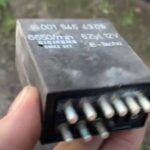The Mercedes R107 SL-Class, a legendary roadster admired for its timeless design and engineering excellence, continues to capture the hearts of classic car enthusiasts. Central to the R107’s reliable operation is the fuse box, a critical component that safeguards the vehicle’s electrical system. In this article, we explore the location of the fuse box in the Mercedes R107, providing essential insights to help owners and enthusiasts effectively maintain and troubleshoot the electrical system of their cherished roadsters.
Understanding the Fuse Box’s Importance
The fuse box in the Mercedes R107 plays a vital role in safeguarding the vehicle’s electrical system. It houses multiple fuses, which are designed to protect various electrical circuits from overloading and potential damage caused by electrical faults. When an electrical overload or short circuit occurs, the fuse will blow, interrupting the circuit and preventing further damage to the vehicle’s sensitive electronic components.
Locating the Fuse Box in the Mercedes R107
The location of the fuse box in the Mercedes R107 can vary slightly depending on the model year and variant. However, it is typically situated in one of two primary locations:
- Early R107 Models (e.g., 350SL and 450SL): For the early models, the fuse box is commonly found in the engine compartment, positioned near the battery or on the driver’s side fender well. It is housed in a black plastic cover with a removable lid, making it easily accessible for inspection and fuse replacement.
- Later R107 Models (e.g., 560SL): In the later R107 models, the fuse box is typically located under the dashboard on the right side. Accessing the fuse box may require the removal of a trim panel or kick panel, depending on the specific model year.
Identifying Fuse Box Components
The fuse box contains multiple fuses, each assigned to protect a specific electrical circuit in the R107. Fuses are color-coded based on their amperage rating, and the fuse box cover often includes a diagram or chart that indicates the purpose of each fuse and its corresponding amperage.
Maintaining the Electrical System
Regular maintenance of the electrical system and the fuses within the fuse box is crucial to ensure the R107’s proper functioning. Periodically inspecting the fuses for signs of damage or blown fuses and replacing them when necessary helps prevent electrical issues and potential malfunctions.
Troubleshooting Electrical Problems
In the event of electrical problems, such as malfunctioning lights or non-responsive accessories, owners can conduct basic troubleshooting using the fuse box. By checking the condition of the fuses and replacing any blown fuses, owners can often resolve minor electrical issues without the need for extensive repairs.
Seeking Professional Assistance
For complex electrical issues or if unsure about troubleshooting, it is advisable to seek professional assistance from experienced Mercedes mechanics or automotive technicians. These experts have the knowledge and diagnostic tools to accurately identify and resolve electrical problems effectively.
Conclusion
The fuse box in the Mercedes R107 SL-Class plays a crucial role in protecting the vehicle’s electrical system from potential damage caused by electrical faults. Familiarizing oneself with the fuse box’s location and conducting regular maintenance on the fuses ensures the reliable and safe operation of the classic roadster. For more intricate electrical issues or if unsure about DIY troubleshooting, enlisting the expertise of qualified professionals guarantees that the Mercedes R107 continues to exude its timeless elegance and remains a joy to drive for generations to come.



